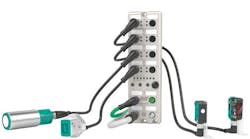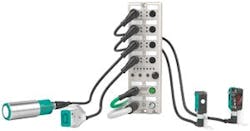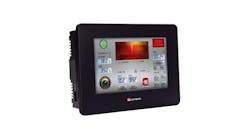Call 330/425-3555, email [email protected] or browse to www.pepperl-fuchs.com.
Adding IO-Link master functionality to an Ethernet I/O module is a step closer to Industry 4.0. Many of the automation hardware manufacturers are onboard with this trend to get connected, send data to the cloud and then access that information."Pepperl+Fuchs manufacturers and sells more than 460 IO-Link-capable devices such as presence sensors, light grids, ultrasonic and position measurement systems," says Danius Silgalis, product marketing manager, Intelligent Systems, at Pepperl+Fuchs. "This IO-Link master helps to connect them all, and the number will continue to grow. With our vast offering of IO-Link-capable devices, it is a logical step to be able to connect all these devices to an IO-Link master module that can concentrate the data and send it upward to controllers via high-level Ethernet networks and on to the cloud."
The new module is multi-protocol-capable out of the box, connecting to EtherNet/IP and Profinet with EtherCAT connectivity planned. "The industrial standard in the Internet of Things (IoT) has been Ethernet and many industrial automation products have added this connectivity," says Silgalis. "That's what started this product portfolio in 2017, with Ethernet-based discrete input and output modules. These modules connected to sensors but provided limited diagnostics. IO-Link diagnostics have moved past the I/O module and are now possible at the device level. The IO-Link master sends the data to a higher-level controller such as a PLC, via EtherNet/IP or Profinet, where it is monitored and diagnosed."
[javascriptSnippet ]
[pullquote]The use of IO-Link expands sensor and actuator diagnostics, providing more predictive maintenance instead of reactive, preventive maintenance capability. "Examples of some popular diagnostics monitored include a sensor bypass or disconnection event," says Silgalis. "Another is monitoring a photo eye's signal level over time to detect a dirty lens. An open circuit, overload or wrong sensor connected are other conditions monitored. All can help to diagnose a failure or abnormal condition."
IO-Link has four different types of data monitored: process, status, device and event. The data is exposed in the PLC or within Web-based tools or exposed via integrated Web server using a web browser.
"From a component side, much more information is available," says Silgalis. "While too much information can be a bad thing, it’s where you see the need in an application that is important. If the parameters are available to you, you don't need all of them but should pick and choose important ones, specific to the application."
Pepperl+Fuchs is part of a community of more than 360 suppliers supporting IO-Link devices and products. However, the new Ethernet I/O modules with IO-Link master has some unique capabilities. One is the powering of the module with an L-coded cable which can handle up to 16 A through an M12 plug-in connector. This high current carrying capability, through the module, enables more modules to be daisy-chained to a single power supply.
"IO-Link is a point-to-point connection, not a network," says Silgalis. "Applications such as automated assembly, material handling and packaging machines, where there are large concentrations of I/O devices in an area, are a great application for IO-Link. It increases the information about the devices being connected. Using this IO-Link master also helps to standardize plant design due to its multiple protocol capability, which can reduce spare-part inventory."
The current Pepperl+Fuchs ICE1-8IOL-G60L-V1D Ethernet I/O modules with IO-Link master has four discrete inputs and four discrete outputs. A variety of cables in lengths up to 15 m are available to connect power, communication and sensors to the module.
"In order to configure an IO-Link system, software tools are required. Pepperl+Fuchs has a variety of methods to expose and configure device parameters," says Silgalis. "One is the integrated Web-server capabilities of the module. This provides parameter visibility to an integrator or controls engineer. To parameterize all devices at once, an IO-Link device tool is also available, providing a graphical user interface for the connection to the master and the different types of data in the connected sensors and actuators. Both can be used for initial commissioning of the IO-Link master."
ALSO READ: Design distributed I/O on your machines instead of running bundles of wires
In addition to parameter assignment, these tools can read manufacturers' IODD (IO device description) files to simplify IO-Link device configuration. The tools are also used to assign the connected devices to ports on the master and I/O addresses of the process data within the master.
IO-Link also provides device validation. "It ensures that a replacement device connected to a port is compatible or identical to the device originally configured," says Silgalis. "This helps maintenance to keep the system operating properly. Version 1.1 IO-Link devices enable this auto device replacement where configuration of the failed devices, stored in the IO-Link master or system controller, is transferred to the replacement to speed maintenance."







